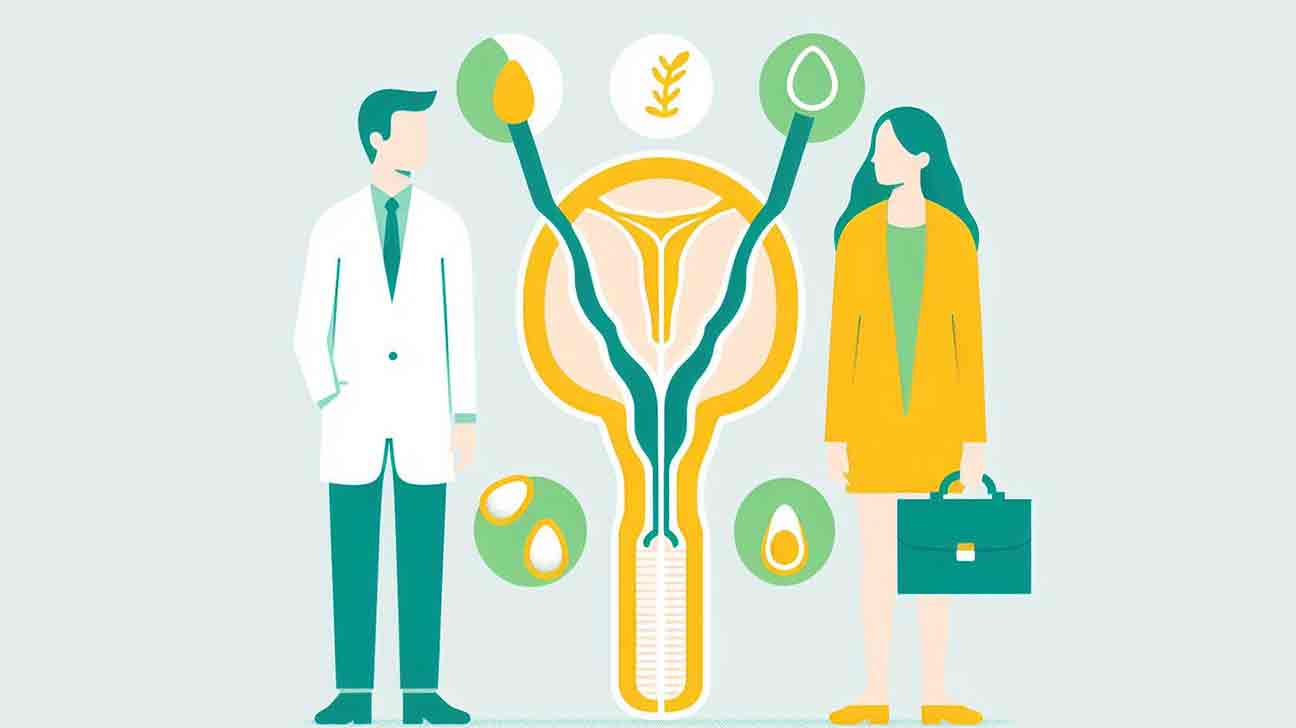There is no fundamental difference between the terms IVF (In Vitro Fertilization) and Test Tube Baby, as they both refer to the same process. However, the terms are often used differently in context. Here’s a breakdown:
IVF (In Vitro Fertilization)
- Definition: IVF is a medical procedure where an egg is fertilized by sperm outside of the body, in a laboratory setting. The term “in vitro” means “in glass” in Latin, referring to the petri dishes or glass containers used in the lab.
- Process: The process includes several stages, such as stimulating the ovaries to produce eggs, retrieving the eggs, fertilizing them with sperm in the lab, and then transferring the resulting embryos to the woman’s uterus.
- Usage: IVF is the scientific term commonly used by medical professionals.
Test Tube Baby
- Definition: The term “test tube baby” is a colloquial term that became popular in the 1970s and 1980s when IVF technology was still new. It refers to a baby conceived through IVF. The phrase can be misleading, as fertilization actually takes place in petri dishes, not test tubes.
- Cultural Reference: It was coined to simplify the explanation of the process for the general public but is less commonly used in scientific contexts today.
Key Point
Both terms describe the same procedure, but IVF is the accurate and preferred term used in modern medical discussions, while test tube baby is more of an outdated or layman’s term used historically to describe babies conceived through IVF.
Conclusion
IVF is the clinical process, while “test tube baby” is a non-technical term that was historically used to describe children born via IVF technology. Both describe the same procedure, and there is no real medical difference between the two.
For more information, you can explore resources like:
IVF (In Vitro Fertilization) and the term Test Tube Baby essentially refer to the same process of assisted reproductive technology. However, there is a difference in how the terms are used and understood:
IVF (In Vitro Fertilization):
- Definition: IVF is the scientific term for the procedure where an egg is fertilized by sperm outside of the body, in a laboratory. The term “in vitro” means “in glass,” referring to the petri dish or glass container used for fertilization.
- Procedure: The IVF process involves stimulating a woman’s ovaries to produce eggs, retrieving the eggs, fertilizing them with sperm in the lab, and then transferring the resulting embryo back into the woman’s uterus.
- Usage: IVF is the technical and medical term used by doctors and fertility specialists. It is a precise description of the entire process.
Test Tube Baby:
- Definition: The term “Test Tube Baby” is a colloquial phrase that became widely used in the 1970s and 1980s, when the first successful IVF treatments took place. It refers to a baby conceived through IVF.
- Misconception: The term can be misleading as fertilization occurs in a petri dish, not an actual test tube. However, it gained popularity as a simple way to explain the process to the public.
- Cultural Reference: Though still used occasionally in layman discussions, the term “test tube baby” is less preferred in modern medical conversations.
Summary
Both IVF and “Test Tube Baby” describe the same scientific procedure, but IVF is the accurate medical term, while “Test Tube Baby” is a more informal, outdated expression used to describe babies conceived through IVF.
dallas ivf
Dallas IVF is a leading fertility clinic located in the Dallas-Fort Worth area, specializing in a wide range of assisted reproductive technologies (ART), including In Vitro Fertilization (IVF), intrauterine insemination (IUI), egg freezing, and other fertility treatments. The clinic is known for its state-of-the-art medical technology, personalized treatment plans, and highly experienced reproductive endocrinologists.
Key Services Offered at Dallas IVF:
- In Vitro Fertilization (IVF): The clinic offers comprehensive IVF services, including ovarian stimulation, egg retrieval, fertilization, and embryo transfer. They work with patients struggling with infertility and provide solutions tailored to individual medical conditions.
- Fertility Preservation: Dallas IVF offers options for those looking to preserve their fertility, including egg freezing and embryo freezing, which can be ideal for women planning to delay pregnancy for personal or medical reasons.
- Genetic Testing: They provide preimplantation genetic testing (PGT) to screen for genetic disorders and ensure the healthiest possible embryo is selected for transfer.
- Donor Egg and Surrogacy Programs: Dallas IVF supports patients needing donor eggs or surrogacy, helping them navigate the complex process with legal and emotional support.
- Male Infertility Treatments: The clinic also addresses male infertility through diagnostic testing and procedures such as Intracytoplasmic Sperm Injection (ICSI).
Success Rates and Expertise
Dallas IVF is recognized for its high success rates, especially in challenging cases like advanced maternal age or previous IVF failures. Their board-certified physicians and experienced embryologists use the latest reproductive technologies to maximize the chances of successful pregnancies.
Locations
The clinic has multiple locations in the Dallas-Fort Worth area, making it accessible to patients from across the region. Each center is equipped with advanced laboratories and comfortable facilities designed to support patients through their fertility journey.
For more information about services and booking consultations, visit the Dallas IVF website.
psychological experience ivf pgt-a
The psychological experience of undergoing IVF (In Vitro Fertilization) combined with PGT-A (Preimplantation Genetic Testing for Aneuploidy) can be emotionally complex and challenging for many patients. While IVF itself is already a physically and emotionally taxing process, adding PGT-A introduces additional layers of stress and hope due to the increased focus on genetic health.
1. Anticipation and Hope
- Many patients undergoing IVF with PGT-A may feel hopeful because PGT-A aims to identify chromosomally normal embryos, which can increase the chances of a healthy pregnancy and reduce the risk of miscarriage.
- There is often a sense of optimism that the genetic testing will improve the success rate of IVF, which can be a significant source of comfort, especially for patients with a history of failed IVF cycles or recurrent miscarriages.
2. Emotional Roller Coaster
- Waiting for Results: The waiting period for PGT-A results can be incredibly stressful. Patients often experience anxiety as they await news of how many embryos are genetically viable. The uncertainty during this phase can lead to a wide range of emotions, from optimism to fear.
- Disappointment: If the PGT-A results reveal that none or only a few embryos are normal, patients may feel devastated or experience a sense of loss, especially after investing time, effort, and finances into the IVF process. The idea of not having viable embryos for transfer can feel crushing.
3. Financial and Ethical Stress
- Financial Concerns: PGT-A adds significant costs to an already expensive procedure. For many patients, the added financial burden can be stressful, especially when considering the uncertain outcome of the IVF cycle.
- Ethical Dilemmas: Some patients face ethical concerns regarding the selection of embryos based on their chromosomal makeup. This can cause internal conflict, as they may struggle with decisions related to which embryos to transfer or discard.
4. Grief and Loss
- Miscarriage Prevention: While PGT-A is designed to reduce miscarriage rates by selecting embryos without chromosomal abnormalities, patients may still experience grief if a transfer does not result in a pregnancy or if a miscarriage occurs despite genetic testing.
- Loss of Potential Embryos: The process of eliminating genetically abnormal embryos may feel like a loss to some patients, even if the embryos were not viable.
5. Coping and Support
- Many patients benefit from psychological counseling or support groups to manage the emotional highs and lows of IVF with PGT-A. Having a support network in place is critical for handling the various emotional challenges.
- Mindfulness and stress-reduction techniques can help mitigate the emotional impact, allowing patients to manage anxiety and maintain emotional well-being throughout the process.
6. Sense of Control
- On the positive side, many patients feel empowered by the PGT-A process. By gaining insight into the genetic health of their embryos, patients often feel more in control of the IVF process, making decisions based on knowledge rather than uncertainty.
Conclusion
The psychological experience of IVF with PGT-A is highly individual, but it often involves a mixture of hope, anxiety, and emotional resilience. The process can be taxing, but for many, the potential for a successful pregnancy and the reduced risk of genetic abnormalities make it worthwhile. Psychological support and counseling can play a vital role in helping patients navigate these emotional complexities.

IVF is a type of assisted reproductive technology; test tube baby is a term that refers to a baby conceived through IVF. IVF involves combining eggs and sperm outside the body in a lab, while “test tube baby” is an informal term that emerged following the birth of the first baby conceived via IVF, highlighting the fact that conception occurred in a laboratory setting, as opposed to natural conception.
The process of in vitro fertilization (IVF) has revolutionized fertility treatments, offering hope to millions of couples struggling with infertility. With its introduction in 1978, the term “test tube baby” became a popular colloquialism, capturing public fascination with the idea of a child being conceived outside of the mother’s womb.
IVF procedures entail retrieving eggs from the mother’s ovaries, fertilizing them with sperm in a lab, and implanting the resulting embryo into the mother’s uterus. This breakthrough technology has given rise to a thriving industry focused on helping individuals and couples achieve their dreams of parenthood through medical intervention. As the field advances, IVF continues to be a beacon of possibility for those facing reproductive challenges.
What Is Ivf?
In vitro fertilization (IVF) is an advanced fertility treatment. It helps those who struggle to have a baby. Doctors create embryos in a lab, not in a woman’s body. These embryos are then put back into the woman’s womb.
The Process Of Ivf
IVF involves several steps. First, we give the woman medicines to make more eggs. Then, we take the eggs out of her body. Next, in a lab, we mix these eggs with sperm. This makes embryos. After some time, one or more embryos go into the woman’s womb. This may help her get pregnant.
- Stimulating egg production
- Egg retrieval
- Insemination and fertilization
- Embryo culture
- Embryo transfer
Success Rates Of Ivf
Success rates vary. It depends on the woman’s age and health reasons.
| Age Group | Success Rate |
|---|---|
| Under 35 | 40-45% |
| 35-40 | 25-35% |
| Over 40 | 10-15% |
Benefits Of Ivf
IVF helps many to become parents. Here are some benefits:
- Helps with different infertility issues
- Can use donor eggs or sperm if needed
- Screen for genetic conditions
- Increases the chance of a healthy baby
What Is A Test Tube Baby?
When families dream of welcoming a new member but face challenges, science offers hope. The term ‘test tube baby’ might sound like something from a sci-fi novel, yet it is deeply rooted in modern fertility treatments. Understanding the concept is key to grasping the incredible advancements in reproductive technology today.
Definition Of A Test Tube Baby
A test tube baby is a child conceived outside the mother’s body. Despite the name, no actual test tubes are involved. Created through in vitro fertilization (IVF), these babies begin their journey in a lab setting. Here, eggs and sperm meet not inside fallopian tubes, but in a controlled petri dish environment.
The Process Of Creating A Test Tube Baby
- Collecting eggs: The mother, or an egg donor, provides eggs through a medical procedure.
- Fertilizing eggs: In the lab, sperm from the father or a donor is introduced to the eggs.
- Observing development: The fertilized eggs, now embryos, are monitored for growth.
- Transferring embryos: Healthy embryos get transferred to the mother’s uterus, hoping for implantation and a successful pregnancy.
Risks And Ethical Concerns
| Risks | Ethical Concerns |
|---|---|
| Multiple births leading to complications | Debate over embryo rights |
| Ovarian hyperstimulation syndrome | Genetic screening dilemmas |
| Emotional and financial strain | Surrogacy and donor anonymity issues |

Main Differences Between Ivf And Test Tube Baby
The terms ‘IVF’ and ‘test tube baby’ conjure images of hope and science bringing new life into the world. But what do they really mean, and how do they differ? Understanding these nuances is key for couples considering assisted reproductive technology to start their families.
Conceptual Difference
People often use ‘IVF’ and ‘test tube baby’ to mean the same thing. But they vary slightly. IVF is a process. Test tube baby is the term for a baby born through this process. IVF stands for In Vitro Fertilization. ‘In Vitro’ means ‘in the lab’ and not in the woman’s body.
Procedure Differences
- IVF involves stimulating the ovaries, retrieving eggs, fertilizing them with sperm in a lab, and transferring the embryo to the uterus.
- A test tube baby results after an embryo from IVF is successfully implanted and leads to a birth.
Success Rates Comparison
| IVF Cycle | Success Rate |
|---|---|
| First | Varies based on factors like age, health |
| Subsequent | May increase with more tries |
Cost Differences
The cost of IVF can be significant and varies widely. It often depends on location, clinic, medication, and the number of cycles. Generally, the cost includes all steps leading up to the birth of a test tube baby.
Availability And Accessibility
While IVF is available globally, access can depend on local laws, healthcare systems, and insurance coverage. Clinics offer different technologies and success rates, which impacts both availability and success for those wanting a test tube baby.
Which Option Is Best?
Deciding between IVF and test tube baby procedures often leads to confusion. Both terms relate to assisting conception, yet they spark different questions. The choice between them hinges on various factors.
Factors To Consider
When contemplating which fertility option reigns supreme, consider these:
- Success Rates: The likelihood of pregnancy varies with each method.
- Cost: Treatment expenses could influence your decision.
- Medical History: Past health records might affect outcomes.
- Techniques Involved: Each procedure utilizes distinct medical protocols.
Individual Circumstances
Babies are miracles, but paths to parenthood differ. The ‘best’ option depends on unique cases:
| Aspect | IVF | Test Tube Baby |
|---|---|---|
| Age | Older couples tend toward IVF. | Younger individuals might prefer this. |
| Health Conditions | Suitable even with certain disorders. | Best if there are no major health issues. |
Consultation With A Healthcare Professional
Expert guidance tailors your fertility journey. Benefits of consulting a doctor include:
- Personalized Advice: Get recommendations suited to your scenario.
- Informed Decisions: Learn all about procedures, risks, and benefits.
- Support: Emotional and psychological backing aids your choice.
Discuss goals, concerns, and options with a fertility specialist for clarity.

Frequently Asked Questions For What Is The Difference Between Ivf And Test Tube Baby
What Is Ivf?
IVF, or in vitro fertilization, is an assisted reproductive technology. It involves combining eggs and sperm outside the body in a lab. Once an embryo or embryos form, they are then placed in the uterus.
How Is “test Tube Baby” Related To Ivf?
The term “test tube baby” refers to a child conceived through IVF. The process occurs in a laboratory setting, sometimes visually compared to a “test tube,” although actual test tubes are not used.
Are Ivf And Test Tube Baby Procedures The Same?
Yes, IVF and the test tube baby procedure refer to the same fertility treatment. Test tube baby is a non-scientific term that has been historically used to describe babies born through IVF technology.
What Is The Success Rate Of Ivf?
The success rate of IVF varies based on several factors including age, cause of infertility, and clinic choice. Generally, the younger the woman, the higher the success rate.

Conclusion
Understanding the distinction between IVF and test tube baby is crucial for couples exploring fertility options. Both terms often intertwine, but knowing that ‘test tube baby’ is an older reference to IVF babies helps clarify the concept. As science advances, it’s vital to stay informed on reproductive technologies that open doors to parenthood for many.
Whether it’s IVF or any other assisted reproductive technique, the journey to bringing new life into the world is a remarkable one.



